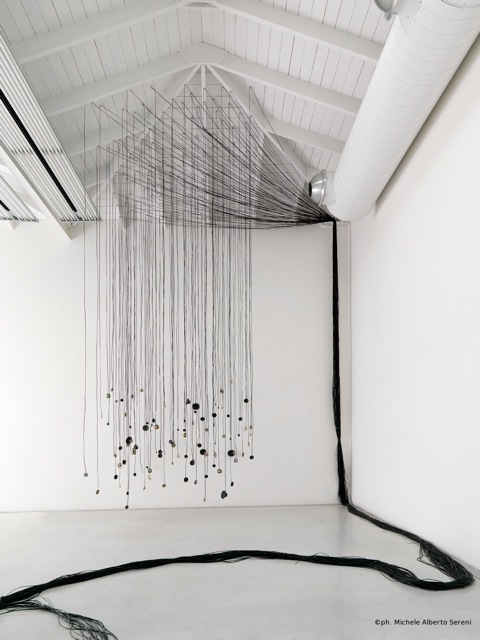
Roberto Pugliese
Unità minime di sensibilità speaker, circuits, computers, sound cards, cables, sensors, software
2011
We're used to seeing technology as a means to an end. However, while we consider a simple device to solve problems at the same time we load it with symbols, expectations and fears. But while we were busy trying to define it, something happened that changed the cards on the table, changing the scene forever: technologies and human beings have become intimate. With the advent of personal computers, and then with the miniaturization of electronic circuits - not to mention prosthesis and biotechnology - we had the opportunity to confront ourselves at a direct and emphatic level with the machines, they have become part of our daily lives by changing the thoughts, gestures, habits, mediating interpersonal relationships. This mutation, passed unnoticed for a long time, is fundamental to understand how difficult it is today to define a boundary between natural and artificial, as our bodies and our minds are inextricably linked to the digital language, conceptual filter and principle guide of the contemporary vision of the world . The electronic art – has been fundamental for analyzing and relating these complexes relationships: between analogue and digital, organic and inorganic, natural and technological. In the case of the works of Roberto Pugliese , the machine - and more specifically, the software - has become a device at the service of life. A system that captures the energies of nature and channels them into a work of art that becomes a living object, changeable and unpredictable. But far from splitting itself which often happens in the art of technology, the work manifests itself powerfully expressing his physicality and a sculptural quality, or even monumental. This is the case of small units of sensitivity (2011), a large interactive installation of sound. Interactivity in this case is not with the audience, enjoying the sound environment without being able to determine, but with nature itself. A sensor placed outside the gallery it records data such as light, humidity, temperature, atmospheric pressure and sends them via a wireless connection to a computer. Software converts this information into sound, simulating oscillating circuits, and thus producing sinus waves, the smallest waves obtainable in audio. In the exhibition area, hundreds of speakers supported by long cables - a black willow - transport changes from outside to inside, making them noticeable and in fact "transmuting them". The digital language, in fact, while simplifying and fragmenting the complexity and continuity of natural processes, one that the American artist Robert Mallary defined, in the sixties, allows "the translation between different forms of energy" ( transductive art)
Valentina Tanni 2011
Roberto Pugliese
Unità minime di sensibilità
Installazione sonora interattiva (speaker, circuiti, computer, schede audio, cavi, sensori, software ).
2011
Siamo abituati a vedere la tecnologia come il mezzo per raggiungere un fine. Tuttavia, se da un lato la consideriamo un semplice dispositivo per risolvere problemi, allo stesso tempo la carichiamo di simbologie, aspettative e paure. Ma mentre eravamo impegnati a cercare di definirla, è successo qualcosa che ha cambiato le carte in tavola, modificando per sempre lo scenario: tecnologie ed esseri umani sono diventati intimi. Con l’avvento dei personal computer, e poi con la miniaturizzazione dei circuiti elettronici - per non parlare di protesi e biotecnologie - abbiamo avuto la possibilità di confrontarci con le macchine a un livello diretto ed empatico: sono entrate a far parte della nostra vita quotidiana, modificando i pensieri, i gesti, le abitudini, mediando i rapporti interpersonali. Questa mutazione, passata a lungo inosservata, è invece fondamentale per comprendere quanto sia problematico oggi definire un confine tra naturale e artificiale; quanto i nostri corpi e le nostre menti siano inestricabilmente legati al linguaggio digitale, filtro concettuale e principio guida della contemporanea visione del mondo. L’arte elettronica – per usare un’etichetta poco precisa ma utile a definire il contesto – è stata fondamentale per analizzare e raccontare queste complesse relazioni: tra analogico e digitale, organico e inorganico, naturale e tecnologico. Nel caso delle opere di Roberto Pugliese, la macchina – e più nello specifico, il software – diventa un dispositivo al servizio della vita. Un sistema per “catturare” le energie della natura e canalizzarle all’interno dell’opera d’arte, che diventa così un oggetto vivo, mutevole, imprevedibile. Ma lungi dallo smaterializzarsi, un processo che spesso attiene all’arte tecnologica, l’opera manifesta prepotentemente la sua fisicità ed esprime una qualità scultorea, quando non addirittura monumentale. È il caso di Unità minime di sensibilità (2011), una grande installazione interattiva sonora. Un’interattività che in questo caso non è con lo spettatore, che fruisce l’ambiente sonoro senza poterlo determinare, ma con la natura stessa. Un sensore posto fuori della galleria registra infatti dati come la luce, l’umidità, la temperatura, la pressione atmosferica e li invia, tramite una connessione senza fili, a un computer. Un software trasforma queste informazioni in suoni, simulando dei circuiti oscillatori e producendo così onde sinusoidali, le forme d’onda minime ottenibili in campo audio. Nello spazio espositivo, centinaia di speaker sostenuti da lunghi cavi – un nero salice piangente – trasportano le variazioni dall’esterno all’interno, rendendole percepibili e di fatto “trasmutandole”. Il linguaggio digitale, infatti, pur semplificando e frammentando la complessità e la continuità dei processi naturali, permette quella che l’artista americano Robert Mallary definì, già negli anni Sessanta, “la traduzione tra differenti forme di energia” (transductive art).
Valentina Tanni 2011

